Growing Shiitake Mushrooms in Your Own Backyard
Air Date: Week of September 29, 2023
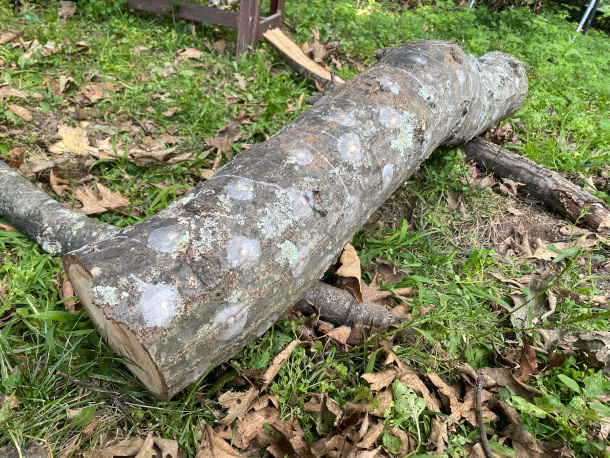
The fully inoculated log, covered in protective wax. (Photo: Aynsley O’Neill)
With a few tools and a fresh log, you can grow delicious mushrooms in your backyard that will come back year after year. Hosts Jenni Doering and Aynsley O’Neill team up to inoculate a log with shiitake mushroom spawn.
Transcript
DOERING: So, Aynsley I could use your help with a backyard experiment.
O’NEILL: Oh? Tell me more.
DOERING: I’m trying to grow shiitake mushrooms. I’ve got a kit and everything.
O’NEILL: Oooh, delicious! Those are so good in soups, pastas and even vegan “bacon”.
DOERING: Yeah! So the kit comes with wood plugs called spawn that are covered in this white fuzzy mycelium. That’s the fungal network that mushrooms sprout from. There’s also some wax to seal the log once the wood plugs are in. And then you just need a drill to make the holes, a hammer and a fresh log. In fact, the wood is what started this whole little experiment, when a big branch fell from the red oak that towers over my backyard. So, first step is drilling some holes in the log. You ready for this?
O’NEILL: Yeah, let’s get to it!
[DRILLING SFX]
O'NEILL: Thank you for using your eye protection, Jenni.
DOERING: Yes. This log is really hard. I swear I know how to use a drill. Oh, there we go.
O'NEILL: Yeah.
[DRILLING SFX]
DOERING: Okay, one row down.
O'NEILL: So your plan is to drill all the holes and then insert the dowels.
DOERING: Yeah. So there's these little plugs, wood plugs, and check out that fuzzy white stuff.
O'NEILL: Yeah.
DOERING: That's the spawn.
O'NEILL: Yeah, at first, I thought it might be bad. Like it might be moldy itself, but I guess that's the point.
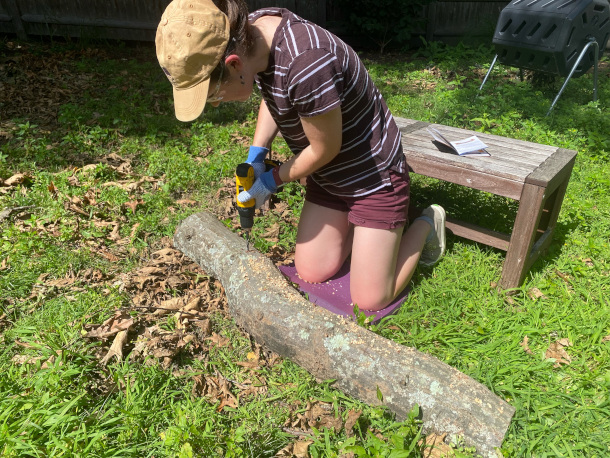
Producer Jenni Doering drills a series of holes into the log. (Photo: Aynsley O’Neill)
DOERING: Yeah, those are the little spawn. I don't think they're called spores at this point. But it's living mushroom stuff.
O'NEILL: Alright. We didn't get this on tape. But I'll say for the record that I also drilled some holes.
DOERING: Yes. I think it should be on record. Aynsley did half of the drilling of the holes as well. All right, let's give it a whack. Yeah.
[HAMMER SFX]
O'NEILL: Perfect.
DOERING: Awesome. Satisfying.
O'NEILL: Now, you said that this is from a red oak? Are there certain kinds of trees that go better with certain kinds of mushrooms?
DOERING: Yes, actually, I guess oaks and shiitakes go well together. There's a whole list here of which species of tree go best with which species of mushrooms. So I love oyster mushrooms.
O'NEILL: Ooh.
DOERING: And those are really good with aspen and cottonwood and willow. If you want hen of the woods, which is a more difficult mushroom to grow apparently, oak is actually the only one that hen of the woods really likes.
O'NEILL: Wow. And there's something cool about sitting in the shade of the oak tree that we're now using.
[HAMMER SFX]
DOERING: Meta, yeah.
O'NEILL: Yeah.
DOERING: Yep. Yeah, this is all very local, except for the spawn. It was shipped to me. I don't know how old that oak is. But it's at least... is that, like, three feet thick?
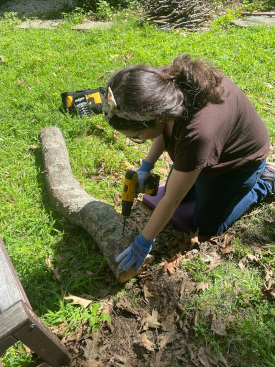
Producer Aynsley O’Neill drills a hole into the log. (Photo: Jenni Doering)
O'NEILL: Looks like it.
DOERING: At the trunk?
O'NEILL: It's pretty glorious.
DOERING: Yeah, it's a big old oak. A lot of the wood went to our friends for firewood this winter.
O'NEILL: Oh, nice.
DOERING: It was a big branch that fell. And then, figured, let's see if we can make some mushrooms out of the rest. Okay.
O'NEILL: Nice.
DOERING: So far, so good.
O'NEILL: Yeah.
DOERING: Do you want to do some?
O'NEILL: I'll do some.
DOERING: All right, let's switch.
[RUSTLING SFX]
O'NEILL: Alrighty. Okay. Eugh!
DOERING: I know. Gross. Do you have a favorite mushroom?
O'NEILL: I don't know. I do think that oyster mushrooms are very tasty and very adaptable. I think we once did a segment were you brought in oysters from a local vegan restaurant for like a vegan Thanksgiving dish?

A mushroom grow kit typically includes mushroom spawn, a drill bit, wax, and a tool to dab wax on the log. (Photo: Aynsley O’Neill)
DOERING: Yes.
O'NEILL: Those were so good!
DOERING: Yeah, the fried oyster mushrooms I believe.
O'NEILL: Yeah.
DOERING: From, from Red Lentil, down the street from here
O'NEILL: Wait, truffles are mushrooms.
DOERING: Yes, they are.
O'NEILL: Truffles are super good. I had truffle potatoes the other day. Those are good.
DOERING: Fancy shmancy!
O'NEILL: Yeah.
DOERING: Yeah, and then I always love getting wood ear mushrooms in my ramen.
O'NEILL: Oh, those are very good.
[HAMMER SFX]
DOERING: Those guys? Delicious. There's a lot of different kinds.
O'NEILL: That's one of the things that's so cool about mushrooms, right? Is that they, they do everything.
DOERING: Yeah. I really like hated mushrooms as a kid. Like, especially cooked mushrooms because they were slimy.
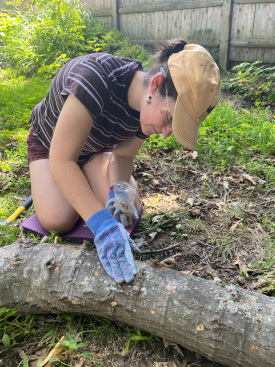
Producer Jenni Doering hammers a spore-covered plug into one of the drilled holes. (Photo: Aynsley O’Neill)
O'NEILL: Oh, yeah.
DOERING: And then, you know, it's weird how when you're a kid, sometimes that switch just flips. And all of a sudden, your least favorite food becomes your favorite food.
O'NEILL: I feel like there's a lot of things where if you just give it enough chances...
DOERING: Yeah.
O'NEILL: Oh my God, I can't aim this hammer for the life of me.
DOERING: It's hard, it's right by a knot.
[HAMMER SFX]
O'NEILL: Yeah, that one went in much easier!
DOERING: Last one! All right.
O'NEILL: Yeah! Nice.
DOERING: Now, for the wax. We're not done yet.
O'NEILL: Oh! I forgot about the wax, I thought now to put it in its home where it can rest forever. No. Let's go get the melted wax!
[RUSTLING SFX]
DOERING: Yeah. All right, so I'll just start. Whoa, it's like turning white as it-
O'NEILL: -as it hardens?
DOERING: Yeah, as it gets on the log.
O'NEILL: It is really cool to see it sort of seal up immediately.
DOERING: I know, right?
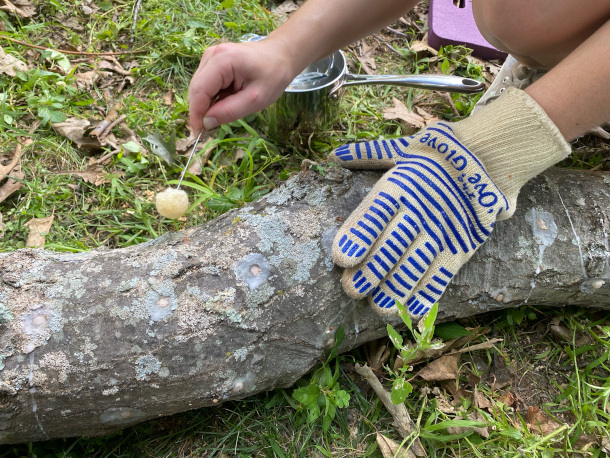
The last step in inoculating a log with mushroom spawn is sealing it with melted wax. (Photo: Aynsley O’Neill)
O'NEILL: As the wax cools so fast. That's so cool.
DOERING: Yeah, it looks like icing now. Maybe I am hungry.
O'NEILL: And so we're sealing it with the wax but why is it important to seal it?
DOERING: So I guess we want the mushrooms that we want. That we like. Shiitake mushrooms. We want those to colonize the log instead of some other random fungi. You know, this isn't a sterile environment so like it's possible that there's other fungi that got in there just while we were drilling and such but I think this is like giving the, the shiitakes a head start.
O'NEILL: Yeah, they're gonna out compete for sure.
DOERING: Yeah, like you saw all that white fungus stuff.
O'NEILL: Yeah.
DOERING: And then they say to set it up in a spot that's not gonna get too dry. So this back corner is nice and shady.
O'NEILL: Yeah.
DOERING: By the compost is kind of a good spot too, maybe, because it's by another rot-
O’NEILL: Decay.
DOERING: -and decay site.
O'NEILL: Just thematically.
DOERING: Yeah, it goes together. This is just gonna require a lot of patience in terms of waiting for mushrooms to appear. But you know once they get going after a year or more, it should produce for like as many years as the log is thick, like, inches.
O'NEILL: Whoa! Inches diameter to years producing?
DOERING: Exactly, like if you have a five or six inch diameter log you should get like five or six years out of it. That's pretty good. So that's that.
O'NEILL: All in day's work, Jenni.
DOERING: Yeah, all in a day's work. Also, can we say shiitake on the radio?
Links
Living on Earth wants to hear from you!
Living on Earth
62 Calef Highway, Suite 212
Lee, NH 03861
Telephone: 617-287-4121
E-mail: comments@loe.org
Newsletter [Click here]
Donate to Living on Earth!
Living on Earth is an independent media program and relies entirely on contributions from listeners and institutions supporting public service. Please donate now to preserve an independent environmental voice.
NewsletterLiving on Earth offers a weekly delivery of the show's rundown to your mailbox. Sign up for our newsletter today!
 Sailors For The Sea: Be the change you want to sea.
Sailors For The Sea: Be the change you want to sea.
 The Grantham Foundation for the Protection of the Environment: Committed to protecting and improving the health of the global environment.
The Grantham Foundation for the Protection of the Environment: Committed to protecting and improving the health of the global environment.
 Contribute to Living on Earth and receive, as our gift to you, an archival print of one of Mark Seth Lender's extraordinary wildlife photographs. Follow the link to see Mark's current collection of photographs.
Contribute to Living on Earth and receive, as our gift to you, an archival print of one of Mark Seth Lender's extraordinary wildlife photographs. Follow the link to see Mark's current collection of photographs.
 Buy a signed copy of Mark Seth Lender's book Smeagull the Seagull & support Living on Earth
Buy a signed copy of Mark Seth Lender's book Smeagull the Seagull & support Living on Earth

